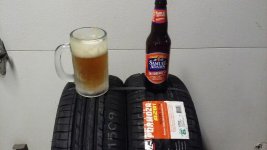KX5062
Well-known member
The
numbers from tires of different sizes cannot be compared directly. Also load rating effects these. IE a 65 series tire with a traction rating of A can have the exact same traction forces measured on a 55 aspect ratio and will have a B.
I can tell you first hand these tires grip well, work wonderfully in the rain and will have no problem going 20k miles. They also balance with next to no weights just like the Yoko rears. They are also a far more comfortable ride than the EVOs which are hard and loud and don't do well in rain at all.
Are they the longest lasting tire in the world, no, but that is not what most folks are looking for.
Oh, and they do not say "Hencho in China" on the side of them.
I'm glad they're working out for you and your customers. I've got the EVO's on my bike and I'm perfectly happy with them. I don't know what noise your referring to, mine are perfectly quiet and I've not had any issue in the rain. I'm sure there are better tires, even the Yokohamas, which usually are a high quality tire, but given the stock sizing of the Federal, cost and performance they work well.
"Traction GradesUTQG Traction Grades are based on the tire's straight line wet coefficient of traction as the tire skids across the specified test surfaces. The UTQG traction test does not evaluate dry braking, dry cornering, wet cornering, or high speed hydroplaning resistance.
The Traction Grade is determined by installing properly inflated test tires on the instrumented axle of a "skid trailer." The skid trailer is pulled behind a truck at a constant 40 mph over wet asphalt and wet concrete test surfaces. Its brakes are momentarily locked and the axle sensors measure the tire's coefficient of friction (braking g forces) as it slides. Since this test evaluates a sliding tire at a constant 40 mph, it places more emphasis on the tire's tread compound and less emphasis on its tread design.
In 1997, the UTQG Traction Grades were revised to provide a new category of AA for the highest performing tires in addition to the earlier A, B and C grades. Previously the A grade had been the highest available and was awarded to tires that offered wet coefficients of traction above 0.47 g on asphalt and 0.35 g on concrete.
Unfortunately the immediate value of this change to tire buyers will be limited. Use of the AA grade will first be seen on new tires that are introduced after the standard was enacted and will then appear later on tires that have had the required wet traction all along, but were introduced when the single A was the highest available grade."

